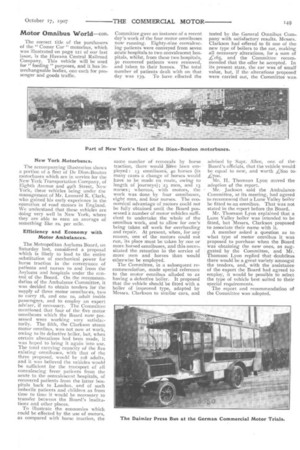Part of New York's fleet of De Dion-Bouton motorbuses.
Page 9

If you've noticed an error in this article please click here to report it so we can fix it.
New York Motorbuses.
The accompanying illustration shows a portion of a fleet of De Dion-Bouton motorbuses which are in service for the New York Transportation Company, of Eighth Avenue and 49th Street, New York, these vehicles being under the management of Mr. Leonard K. Clark, who gained his early experience in the operation of road motors in England. We understand that these vehicles are doing very well in New York, where they are able to earn an average of something like 2s. per mile.
Efficiency and Economy with Motor Ambulances.
The Metropolitan Asylums Board, on Saturday last, considered a proposal which is likely to lead to the entire substitution of mechanical power for horse traction in the conveyance of patients and nurses to and from the Asylums and hospitals under the control of the Board. On the recommendation of the Ambulance Committee, it was decided to obtain tenders for the supply of three motor omnibuTes, two to carry 16, and one ro, adult inside passengers, and to employ an expert adviser, if necessary. The Committee mentioned that four of the five motor omnibuses which the Board now possessed were working very satisfactorily. The fifth, the Clarkson steam motor omnibus, was not now at work, owing to its defective boiler, but, when certain alterations had been made, it was hoped to bring it again into use. The total carrying capacity of the five existing omnibuses, with that of the three proposed, would be ro8 adults, and it was believed the vehicles would be sufficient for the transport of all convalescing fever patients from the acute to the convalescent hospitals, of recovered patients from the latter hospitals back to London, and of such imbecile patients and children as from time to time it would be necessary to transfer between the Board's institutions and other places. To illustrate the economies which could be effected by the use of motors, as compared with horse traction, the same number of removals by horse traction, there would have been employed: 13 omnibuses, 40 horses (in many cases a change of horses would have to be made en route, owing to length of journeys); 23 men, and 13 nurses ; whereas, with motors, the work was done by four omnibuses, eight men, and four nurses. The economical advantage of motors could not be fully obtained until the Board possessed a number of motor vehicles sufficient to undertake the whole of the omnibus work, and to allow for one's being taken off work for overhauling and repair. At present, when, for any reason, one of the motors could not run, its place must be taken by one or more horsed omnibuses, and this necessitated the retention in the service of more men and horses than would otherwise be employed.
The Committee, in a subsequent recommendation, made special reference to the motor omnibus alluded to as having a defective boiler. It proposed that the vehicle should be fitted with a boiler of improved type, adapted by Messrs. Clarkson to similar cars, and
advised by Supt. Allen, one of the Board's officials, that the vehicle would be equal to new, and worth .4;600 to.
Mr. H. Thomson Lyon moved the adoption of the report. Mr. Jackson said the AmbulanceCommittee, at its meeting, had agreed to recommend that a Lune Valley boiler be fitted to an omnibus. That was not stated in the report before the Board.
Mr. Thomson Lyon explained that a Lune Valley boiler was intended to be fitted, but Messrs. Clarkson proposed' to associate their name with it.
A member asked a question as to. what type of motor omnibus it was. proposed to purchase when the Board was obtaining the new ones, as suggested by the Committee, and Mr. Thomson Lyon replied that doubtless. there would be a great variety amongst the tenders, and, with the assistance of the expert the Board had agreed to employ, it would he possible to select the type of vehicle best suited to their special requirements. The report and recommendation of the Committee was adopted.






























